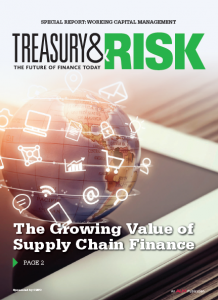By Sean Van Gundy, Managing Director, Working Capital Advisory, C2FO
 Maintaining an optimized working capital strategy is complex enough without geopolitical volatility, fluctuating interest rates and increasing shareholder demands. We've spent the last ten years listening to businesses outline their headwinds alongside their goals before working together to launch digital supplier financing solutions that achieved their key working capital objectives.
Maintaining an optimized working capital strategy is complex enough without geopolitical volatility, fluctuating interest rates and increasing shareholder demands. We've spent the last ten years listening to businesses outline their headwinds alongside their goals before working together to launch digital supplier financing solutions that achieved their key working capital objectives.
While some businesses were focused on improving EBITDA, others were focused on reducing credit risk, and some were simply trying to fully digitize their finance and treasury operations. Regardless of goal, organization size or maturity of the finance and treasury teams, they all share three common denominators that continue to improve their working capital. Consider whether your approach embodies these characteristics and whether you need to adjust your strategy for better results.
Create shared value
The most effective working capital approach benefits not only you, but every one of your business relationships.
Some of the most important relationships your business mantains are with suppliers. Evolving these relationships beyond a transaction of goods and services and into financial collaboration adds a layer of value that creates benefit for both your business and theirs. One such example of financial collaboration between a business and its suppliers is demonstrated by one of the world's largest oil & gas producers with operations and suppliers positioned the globe:
- Primary Goal: Improve financial return on temporary surplus cash.
- Approach: Offer early payment discounts to all suppliers using an existing internal labor-intensive program, which required case-by-case approvals and manual adjustments in multiple ERPs. Given the constricted timeframe of their surplus cash, they recognized this approach would fall short on delivering even a tiny fraction of their desired return.
- Solution: This multinational corporation replaced its homegrown discounting program with the C2FO SaaS-based dynamic-pricing solution that eliminated any human intervention in processing early payments and created evergreen improvement on their cash returns.
- Results: While the primary objective was to maximize returns on cash (they achieved a reoccurring 610bps improvement on current investments), the hidden value was in providing ease of liquidity throughout their supply chain. In doing so, this corporation improved relationships with the suppliers critical to their business and found a leading indicator on market liquidity to measure supply chain health.
Give up control
While it sounds counterintuitive, relinquishing control will produce better results when it comes to pricing discounts in supplier financing programs.
- Weakness: Going back to the previously mentioned multinational oil & gas producer, we can see one of the downfalls to their original approach – they were naming pricing terms in their existing invoice discount model. Projecting 100% accuracy in your cash flows is near impossible, just as it is for the businesses that make up your supply chain.
- Opportunity: Enabling your business partners to price the value of accessing faster invoice payments from you expands the network of participants. Think about it this way, how many households need a car for transportation? How many can afford to buy a Lamborghini compared to those who can afford a Honda? The need is ever present, while price controls transaction volume.

Build your own flexibility
Since you cannot control external factors, embrace solutions that allow you to work around them when the need arises.
If your business is not already deploying a variety of working capital solutions, start looking into your options now. Having a variety of options provides a level of flexibility that allows you to adjust to the changing dynamics of your business and the external factors that interrupt. The key is understanding which tools generate cash flow, or earnings, or both. Conversely, recognize how solutions you offer impact your suppliers and their ability to conveniently access liquidity at costs they can afford.
- Balancing objectives: Whether your goal is to support a range of strategic cash needs driven off events like M&A, dividend hikes, share repurchases, or even debt repayments, ensure you can balance your funding approach with your cash outputs.
- Optimization Tactic: Dynamic digital financing solutions can deploy early payments to your suppliers, while also providing the means to pull down cash faster from your own customers, thus creating unrivaled versatility.
- Benefits: One approach improves margins, while the other stockpiles cash on your balance sheet. And since both are handled in a debt-free environment, you navigate around exposure ratios and covenants while helping your business achieve critical key performance indicators and metrics.
Flexible, convenient and collaborative solutions for monetizing both your customer receivables and accounts payable should be a part of any finance professional's toolkit. With the right tools, you can respond to financial needs in real time despite instability that external factors create. Business is not as predictable as we wish it were and it can be a challenge to maintain balance. But, it's your ability to prevent and manage challenges that makes the balancing act far less daunting.
About Sean Van Gundy
Sean leads the global Working Capital Advisory team at C2FO and specializes in holistic accounts payable, supply chain finance, payment terms standardization and process improvements. He was also responsible for leading the implementation of Walmart's supply chain finance program that served billions in spend and generated hundreds of millions of cash flow. For a comparison of the working capital solutions on the market today and how they impact your business and supply chain, contact Sean at [email protected].
About C2FO
C2FO is changing the way businesses improve their working capital through our simple, yet powerful technology. Utilizing an online marketplace, we connect businesses that want cash with those who have cash. Name your desired price of capital and C2FO algorithms match it with available funding sources. Cash flow comes through early payment of invoices from customers, A/R financing and other lending options. C2FO is the world's largest non-banking solution for businesses across the globe. Learn more at C2FO.com

Sean Van Gundy Managing Director, Working Capital Advisory, C2FO
Also from the September 2019 Special Report:
View the Digital Edition Here: The Growing Value of Supply Chain Finance
Read the Full Article: The Growing Value of Supply Chain Finance
Recommended For You
© Touchpoint Markets, All Rights Reserved. Request academic re-use from www.copyright.com. All other uses, submit a request to [email protected]. For more inforrmation visit Asset & Logo Licensing.




